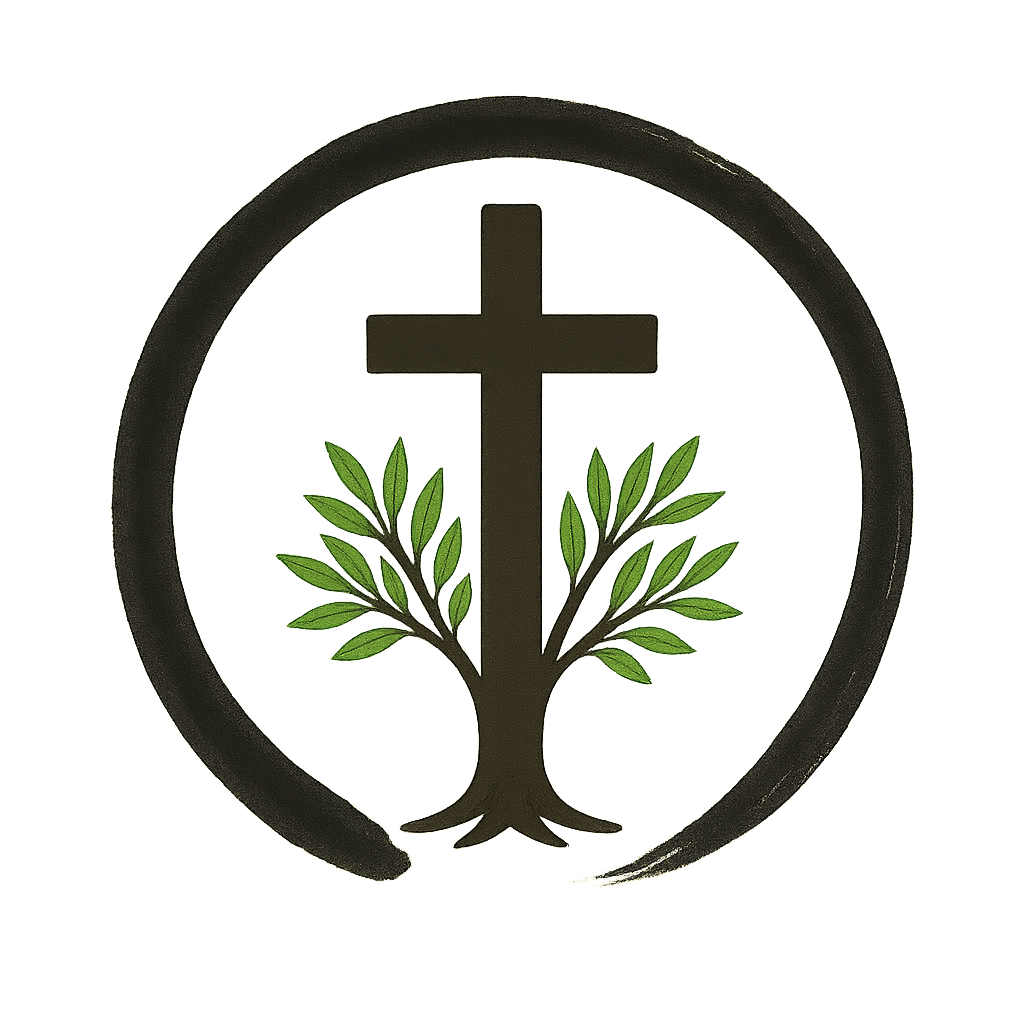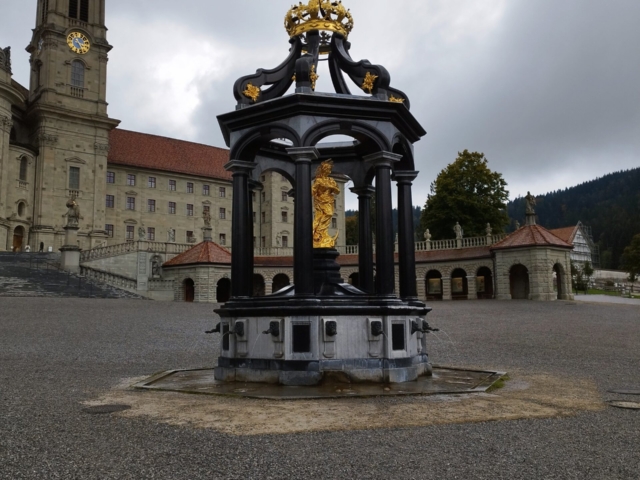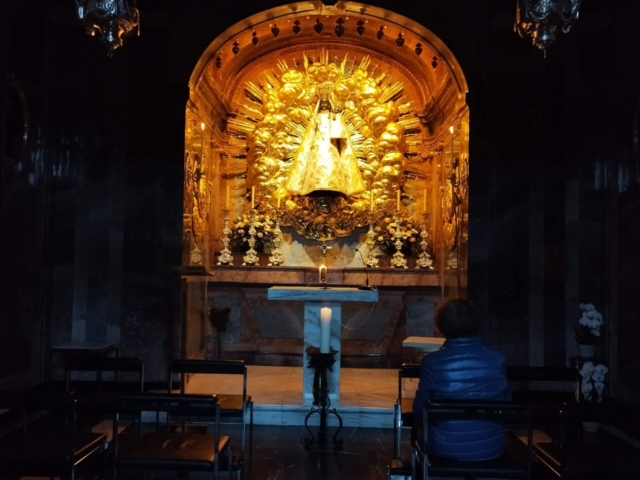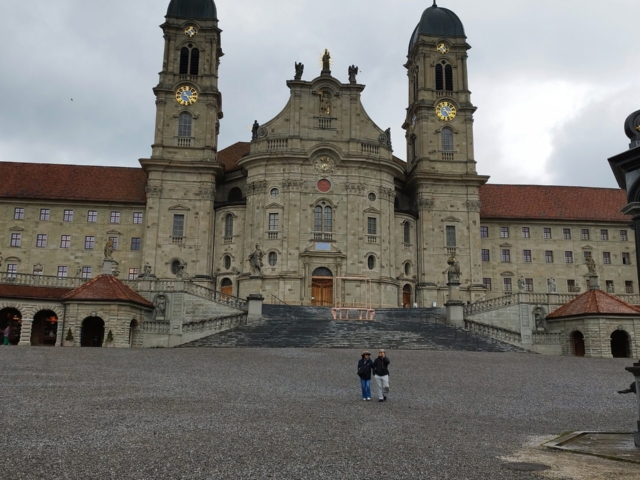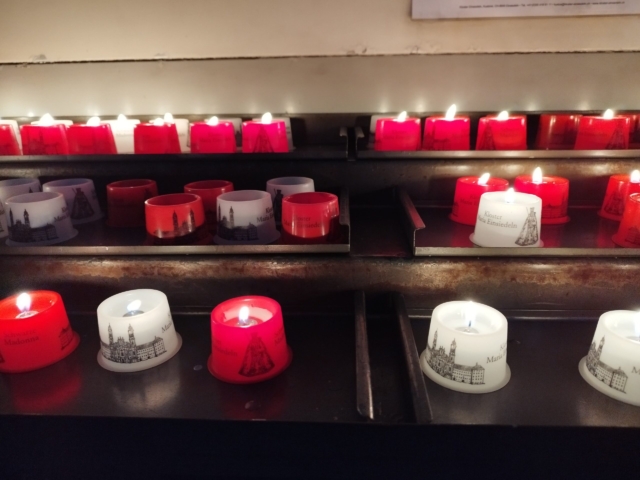Benedictine Monastery Einsiedeln – Mary, our Mother – Black Madonna
Einsiedeln Abbey is a Benedictine monastery and is famous for the Black Madonna. The abbey is the largest pilgrimage site in Switzerland and is located on the Way of St. James.
Benedictine Brother Meinrad - Origin of the Einsiedeln Monastery
In 828, the Benedictine Meinrad withdrew from the Reichenau monastery to the Etzel Pass as a hermit. In 835, he built himself a new hermitage with a small chapel in a remote location. This location was a little further south, in the middle of the Dark Forest. According to legend, Meinrad was visited there by people who asked for his advice and comfort and gave him gifts in return. On January 21, 861, he was attacked and murdered by vagrants. Two ravens are said to have then pursued the murderers and led them to court, where they were sentenced to death at the stake under the chairmanship of Count Adalbert the Illustrious. For this reason, two ravens are depicted on the coats of arms of the monastery and village of Einsiedeln.
Meinrad's Cell
His body was buried on the Reichenau, his heart on the Etzel. Over 40 years later, Meinrad's cell once again became a magnet for hermits. Among them was Benno, who was briefly Bishop of Metz. They settled near the cell in 906 and cultivated the area. In 934, the hermits were brought together into a community by Eberhard, a cathedral provost from Strasbourg, to whom he gave the Rule of Saint Benedict. Eberhard, the first abbot, had his own people, who formed the first population of the high valley. The foundation of the monastery was confirmed on October 27, 947 by King Otto I and was accompanied by a customary donation of land.
Otto I's donation also included the island of Ufenau, which at that time belonged to the Säckingen women's monastery. The women's monastery was compensated for this with other properties. The Einsiedeln monastery also received the free election of an abbot and immunity. In 948, the first abbey church was consecrated in honor of Mary and Saint Maurice. Under the first abbots, the Einsiedeln monastic community developed into a Benedictine monastery that was widely known as an exemplary one. This is evidenced by the fact that numerous monks were called as abbots in other monasteries or to bishoprics. (Wikipedia)
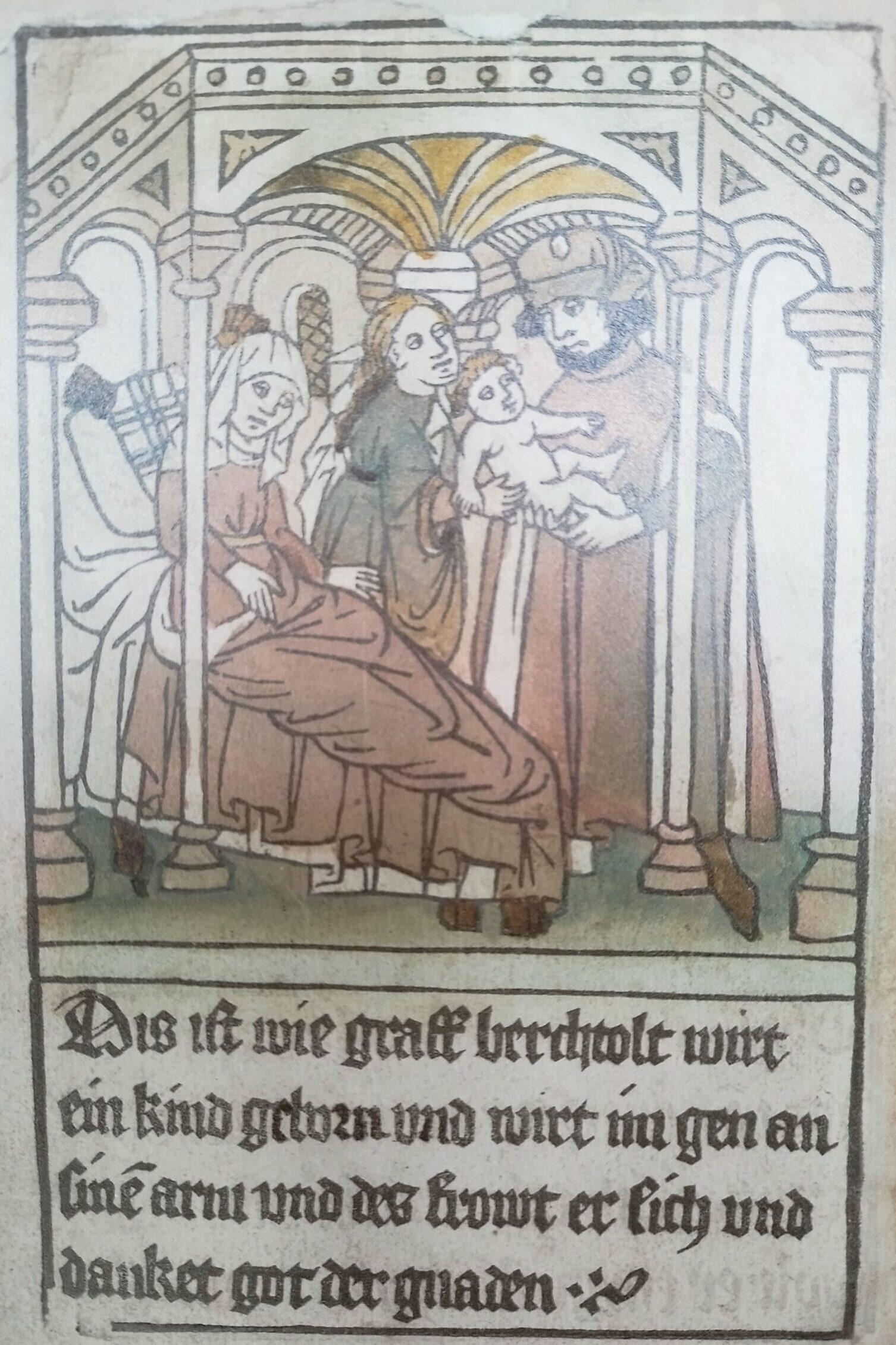
Count Berchthold's long-awaited child is born. The count is said to have lived near Rottenburg am Neckar.
Count Berchthold brings his son Meinrad to the island of Reichenau, where he receives his education.
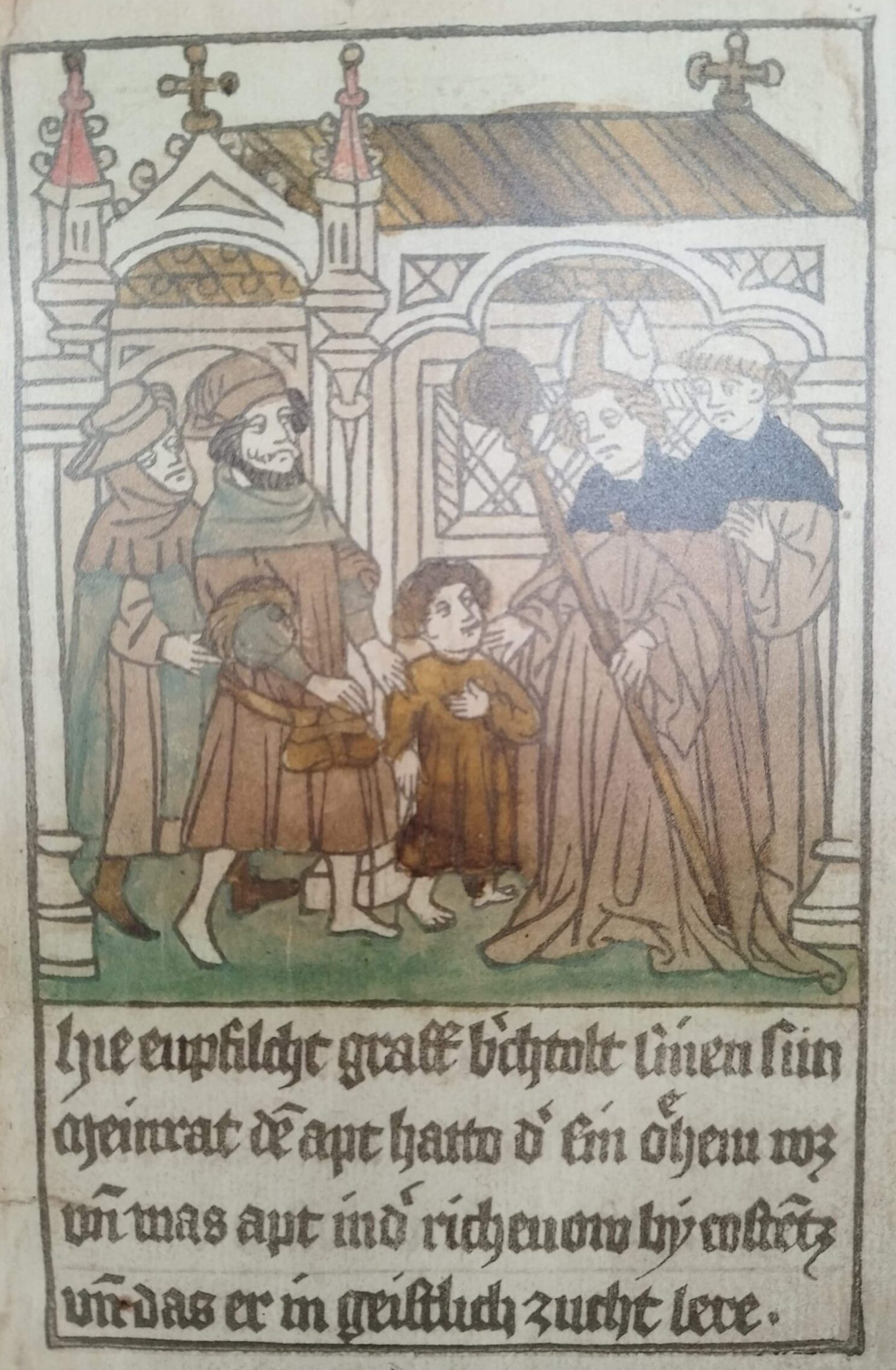
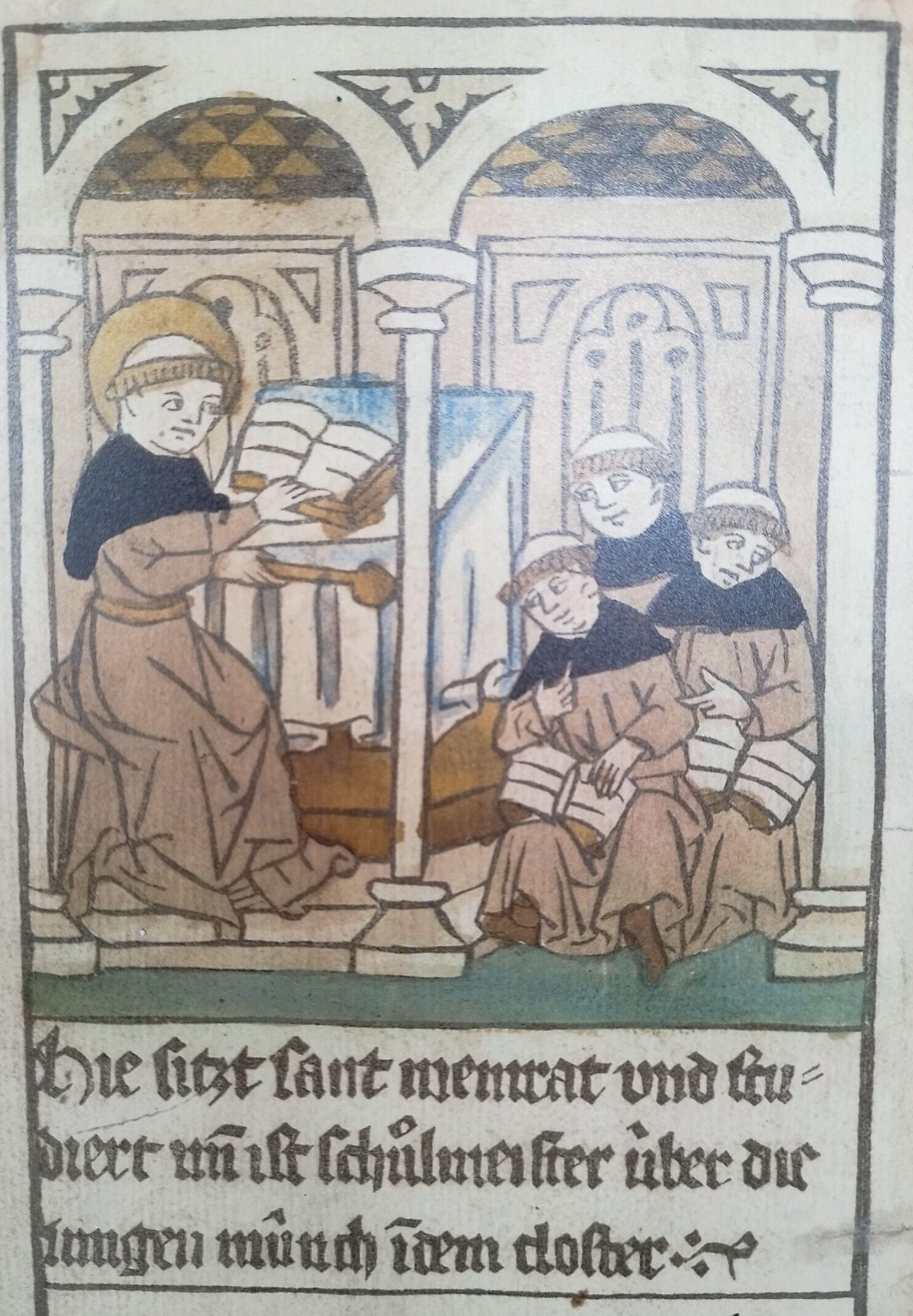
Meinrad becomes a schoolmaster and teaches the young students.
Meinrad is rowing with his students on Lake Zurich. From the boat he can see the place where he wants to build his cell.
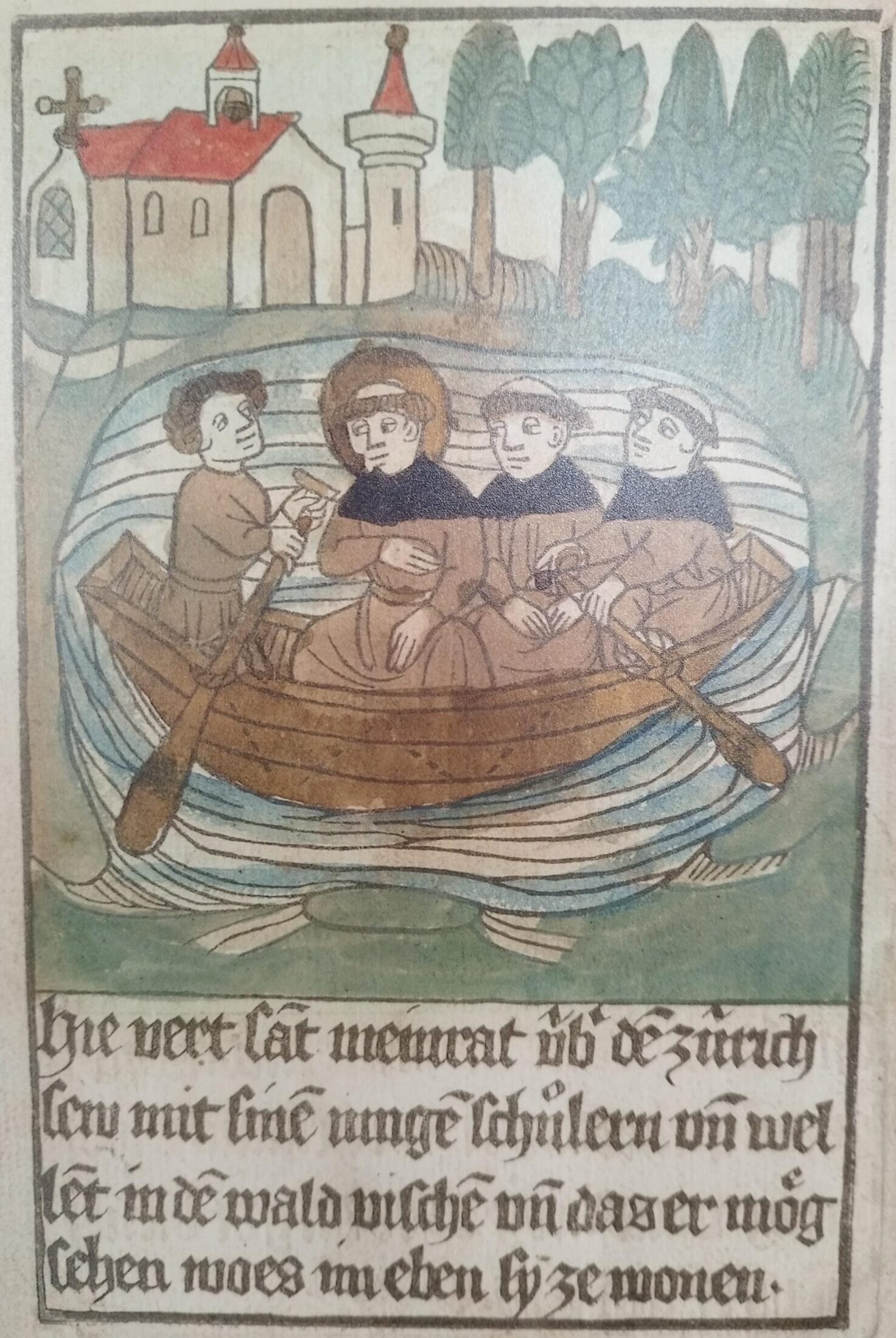
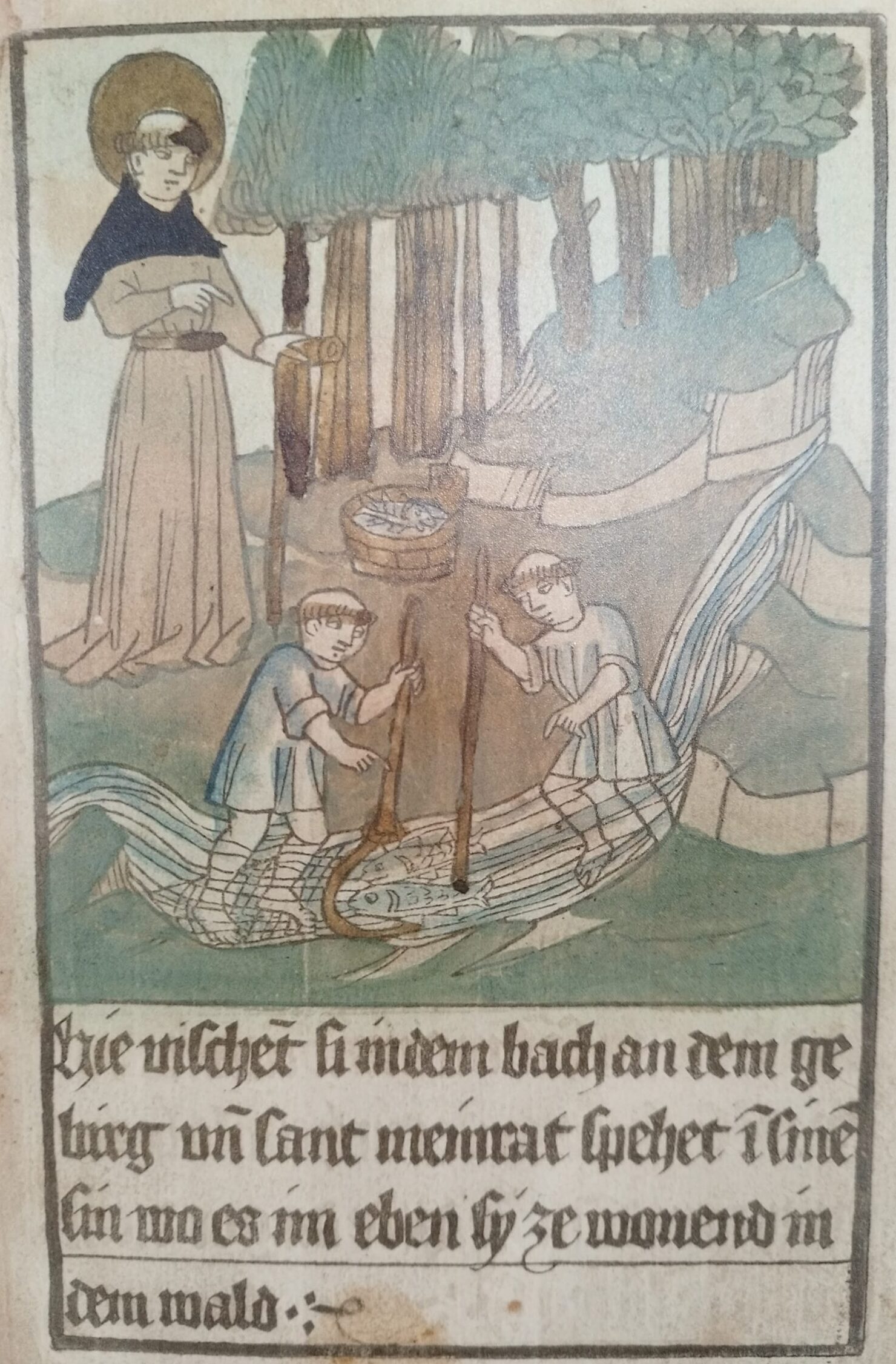
His students fish in the stream where Meinrad will build his cell.
Meinrad retreats further into the Dark Forest and takes with him a nest with two young ravens that will accompany him until his death.
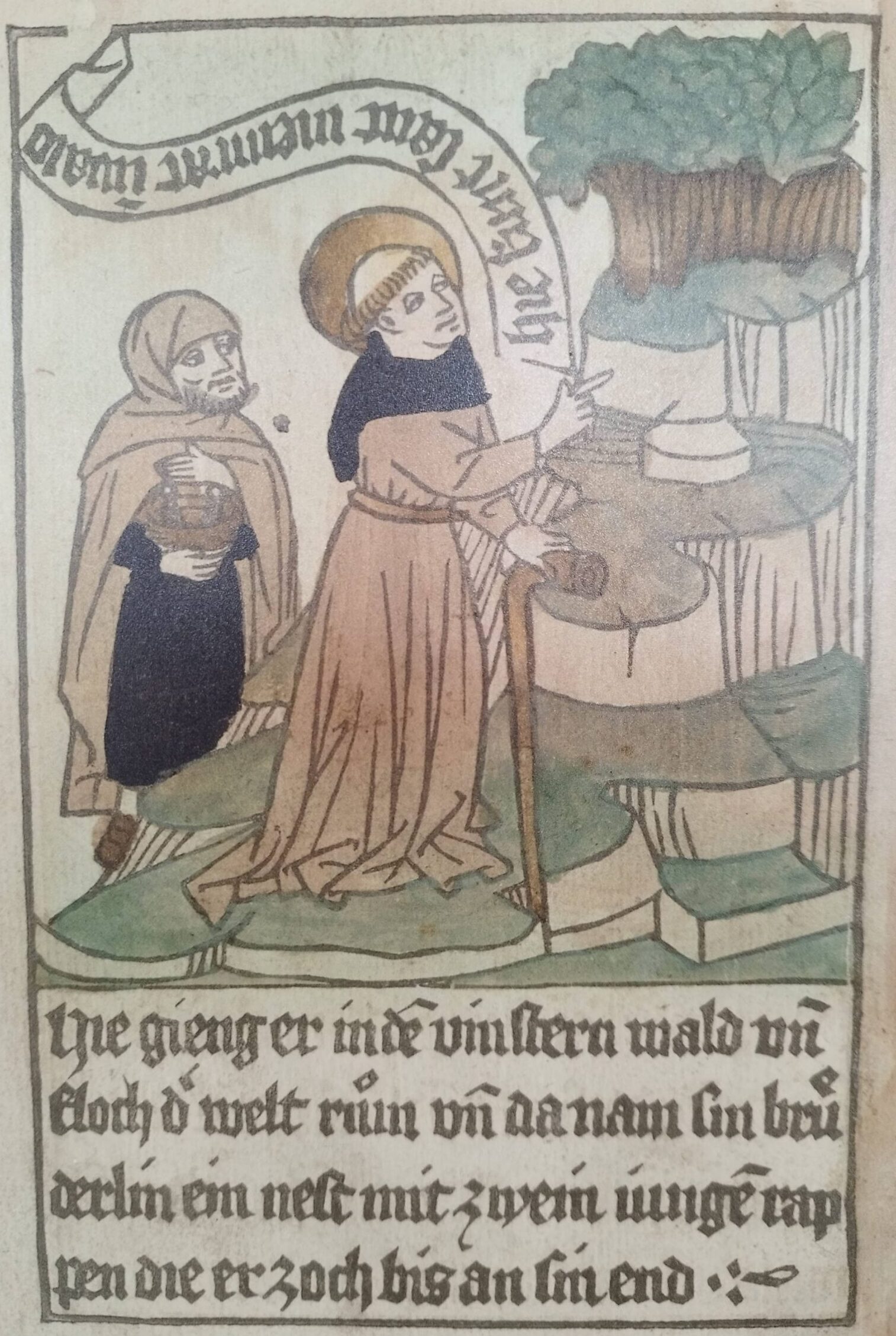
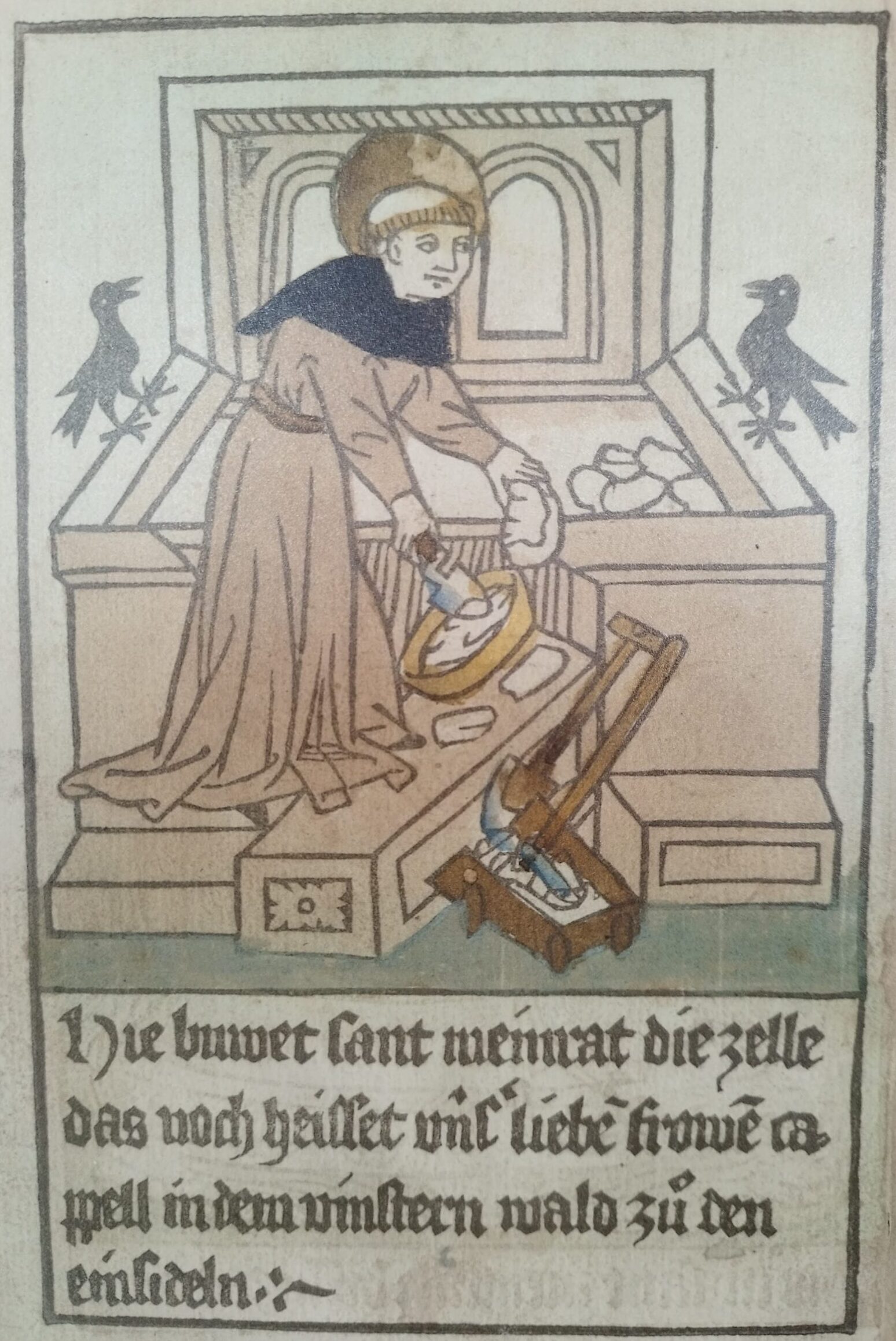
Meinrad builds a chapel in honor of Our Lady in the Dark Forest.
Meinrad gives poor pilgrims bread and wine.
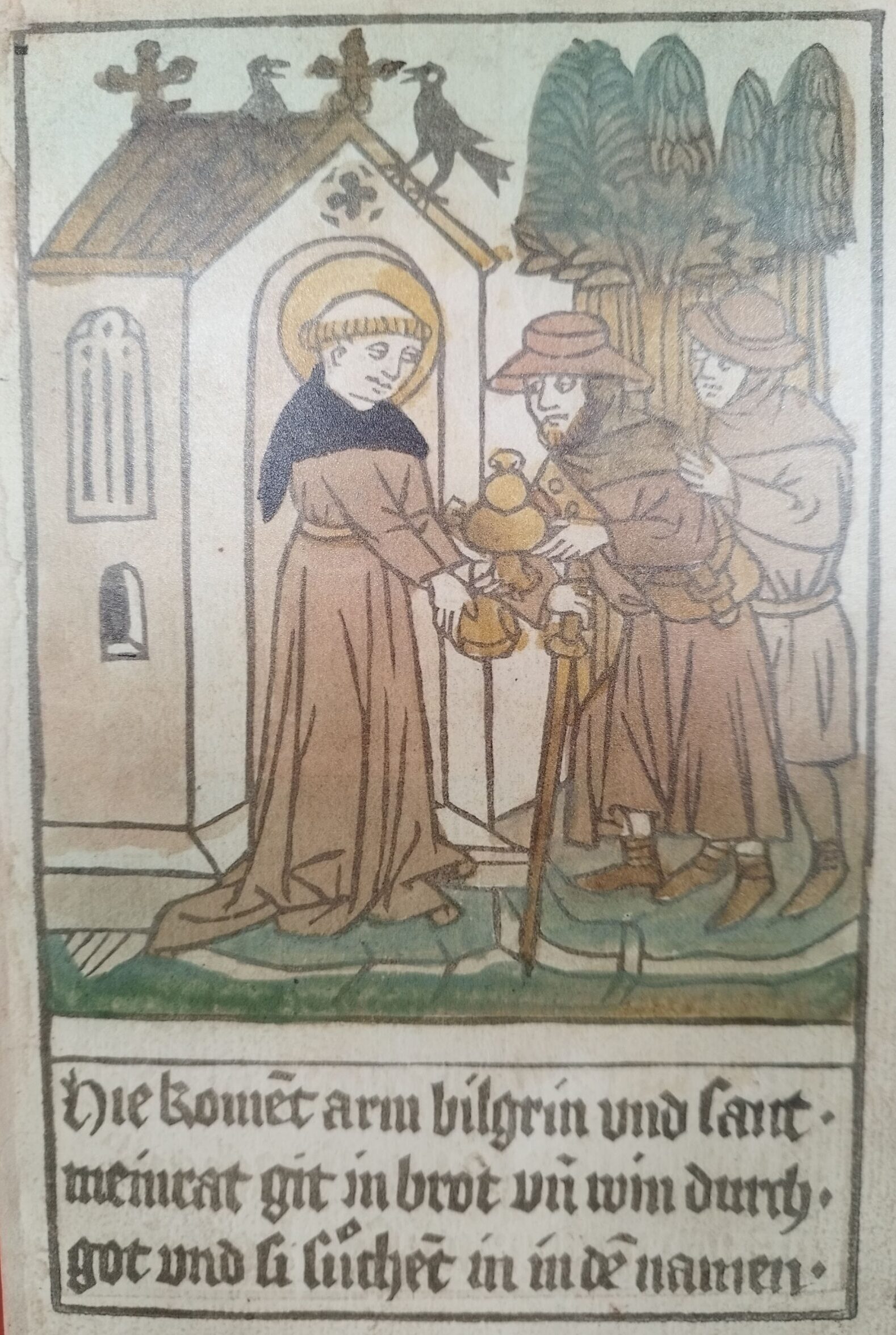
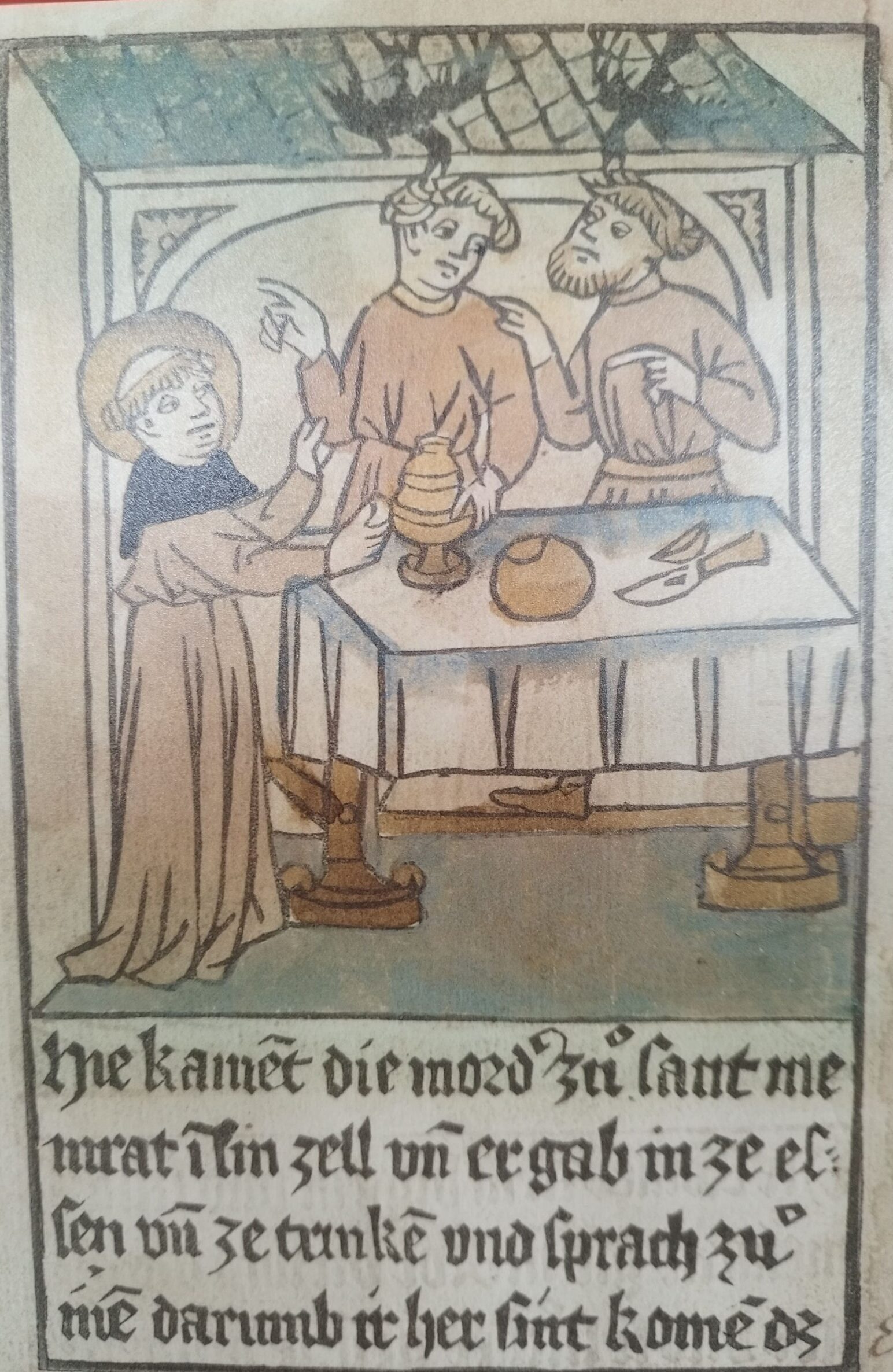
Meinrad gives his murderers something to eat and drink in his cell. Meinrad's two ravens suspect something bad.
Two robbers named Richard and Peter, whom Meinrad believes to be pilgrims, attack the hermit and beat him to death with clubs.
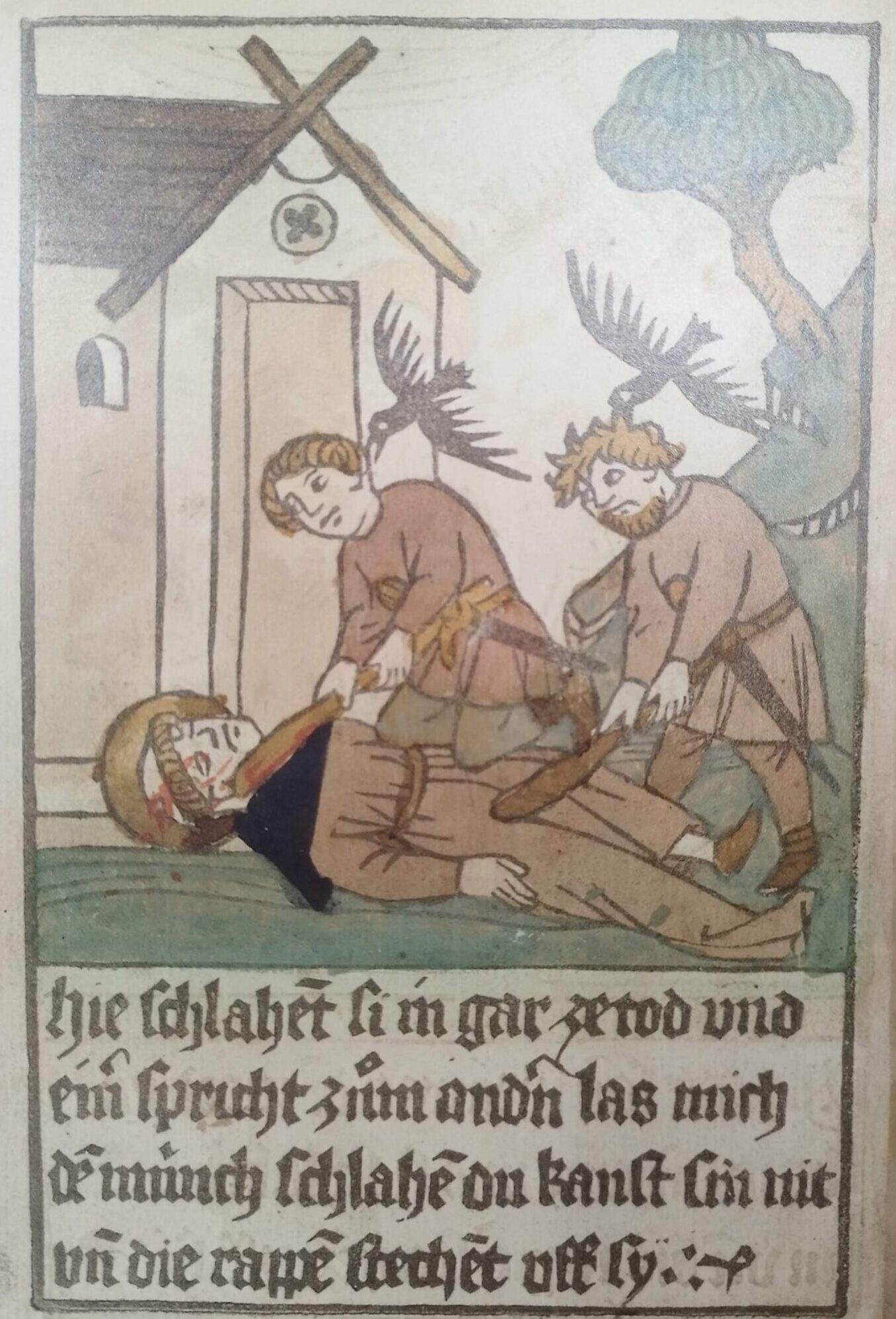
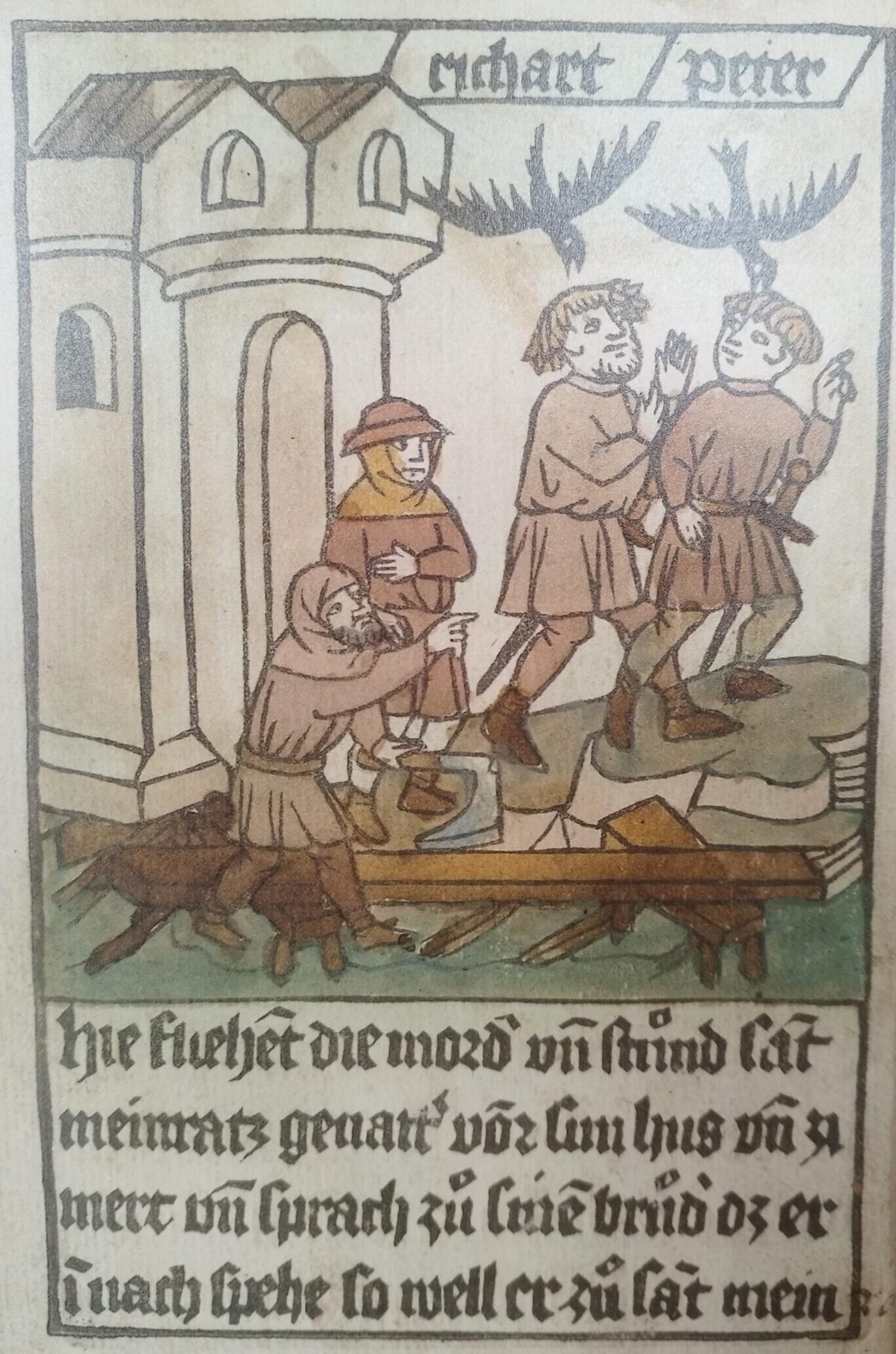
Meinrad’s two ravens pursue the robbers to Zurich, where they are recognized.
There, Richard and Peter are caught and sentenced to death by breaking on the wheel and burning.
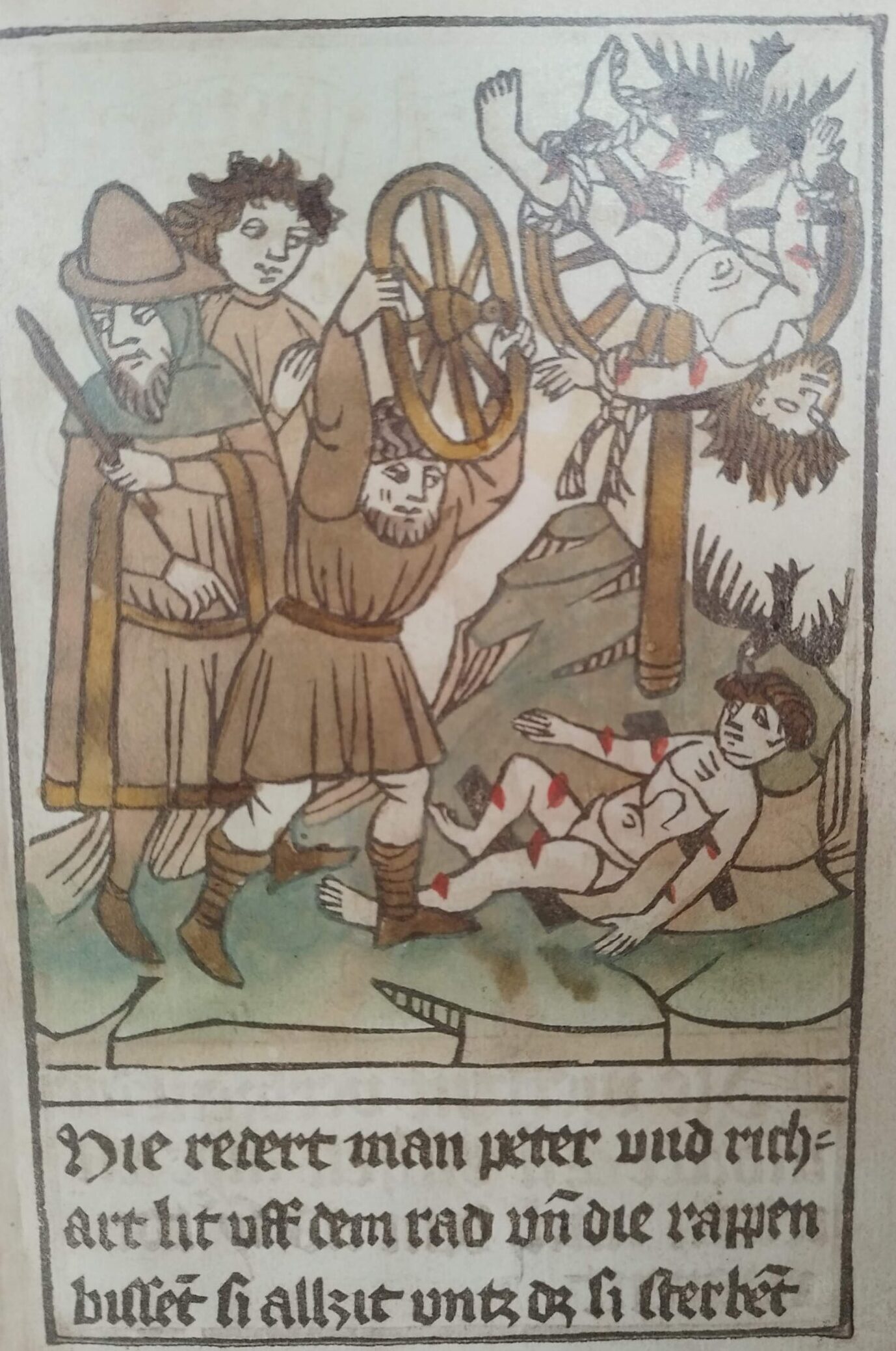
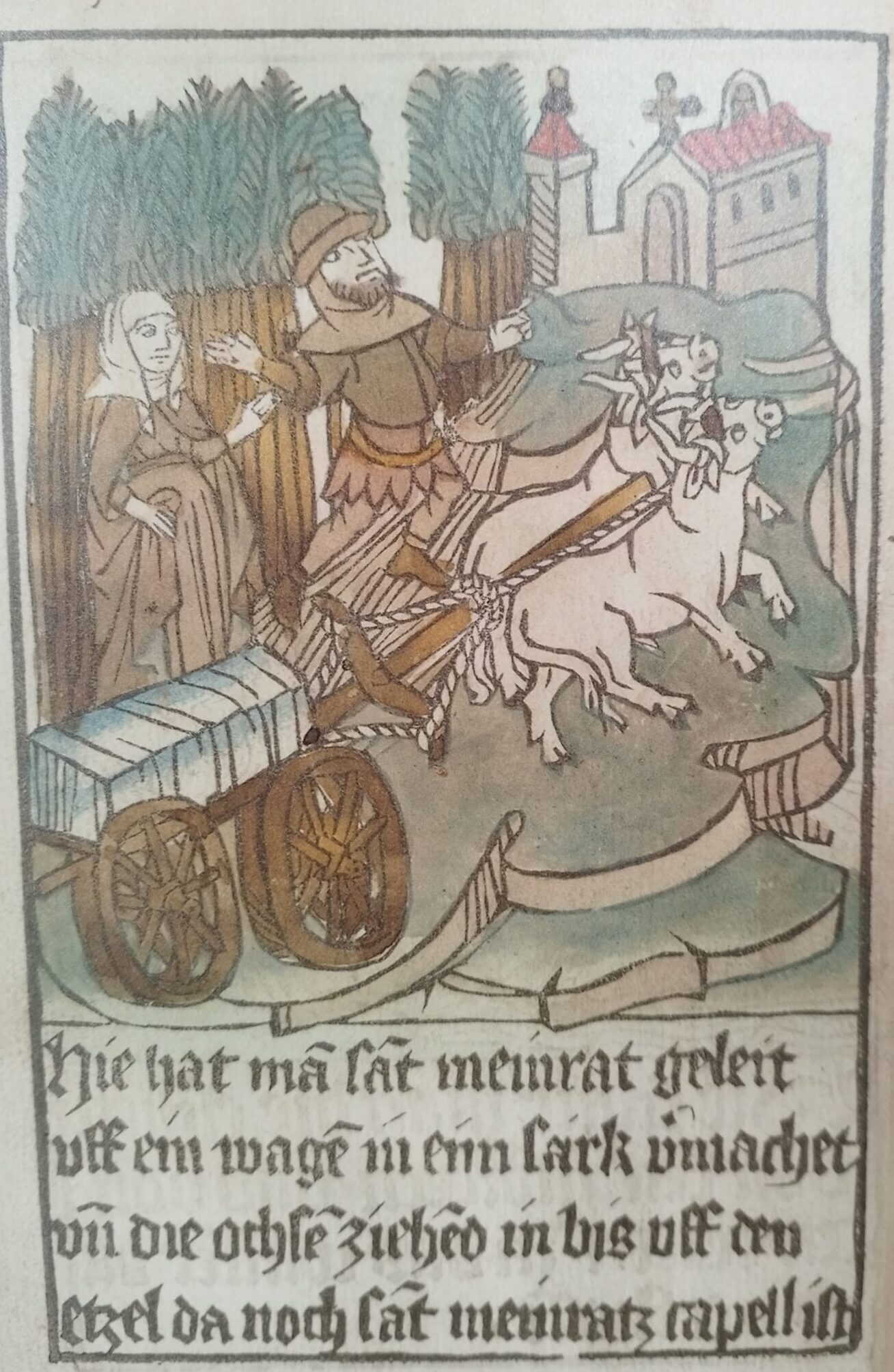
Meinrad’s body is pulled on an ox cart across the Etzel, where his first chapel stands.
Meinrad's cell and the Chapel of Our Lady are falling into disrepair because no one lives there anymore.
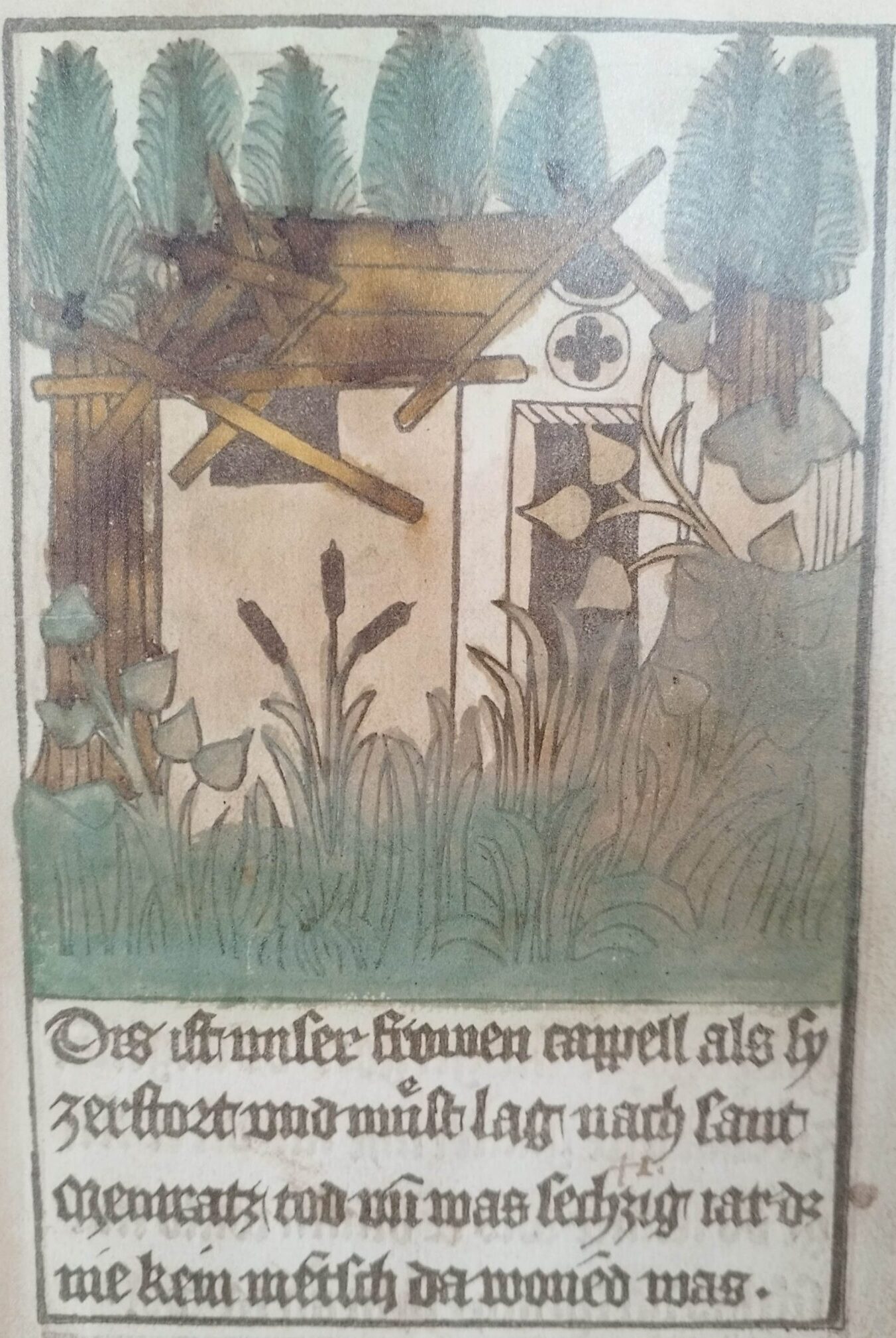
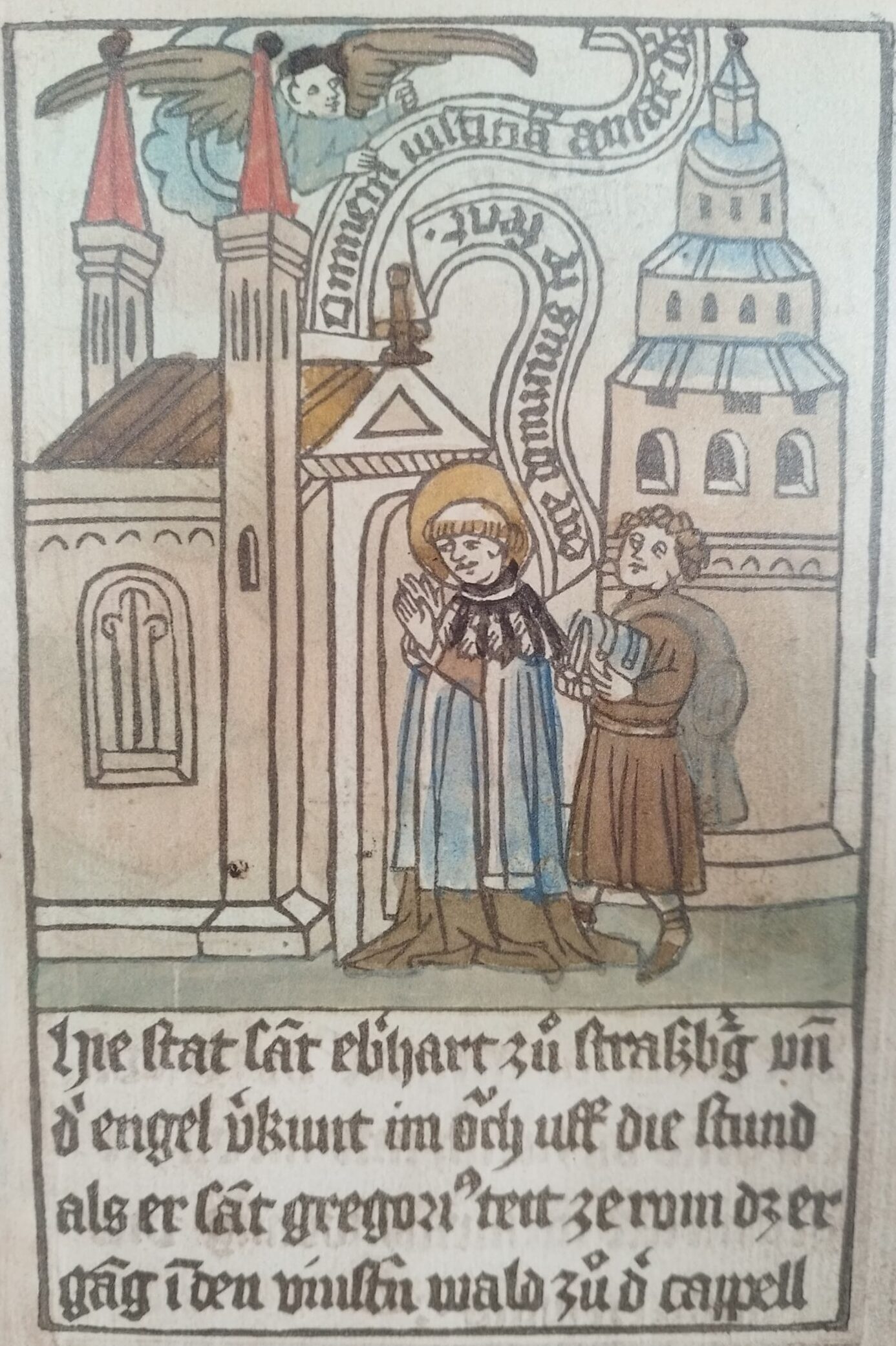
An angel calls Eberhard von Strassburg to go to the place in the Dark Forest where Meinrad's ruined chapel stands.
Eberhard von Strassburg and Gregor, an Anglo-Saxon, rebuild Meinrad's chapel together.
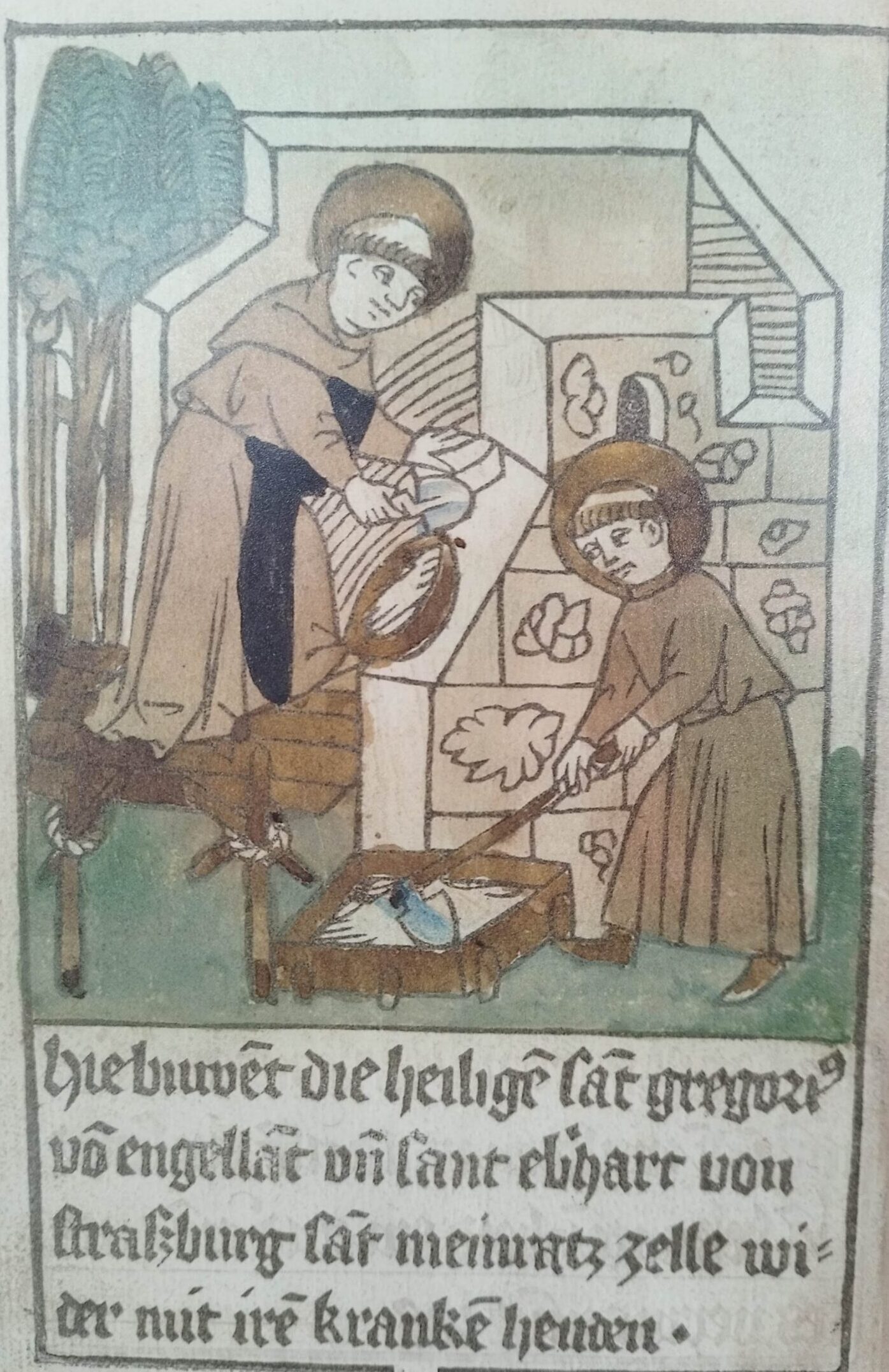
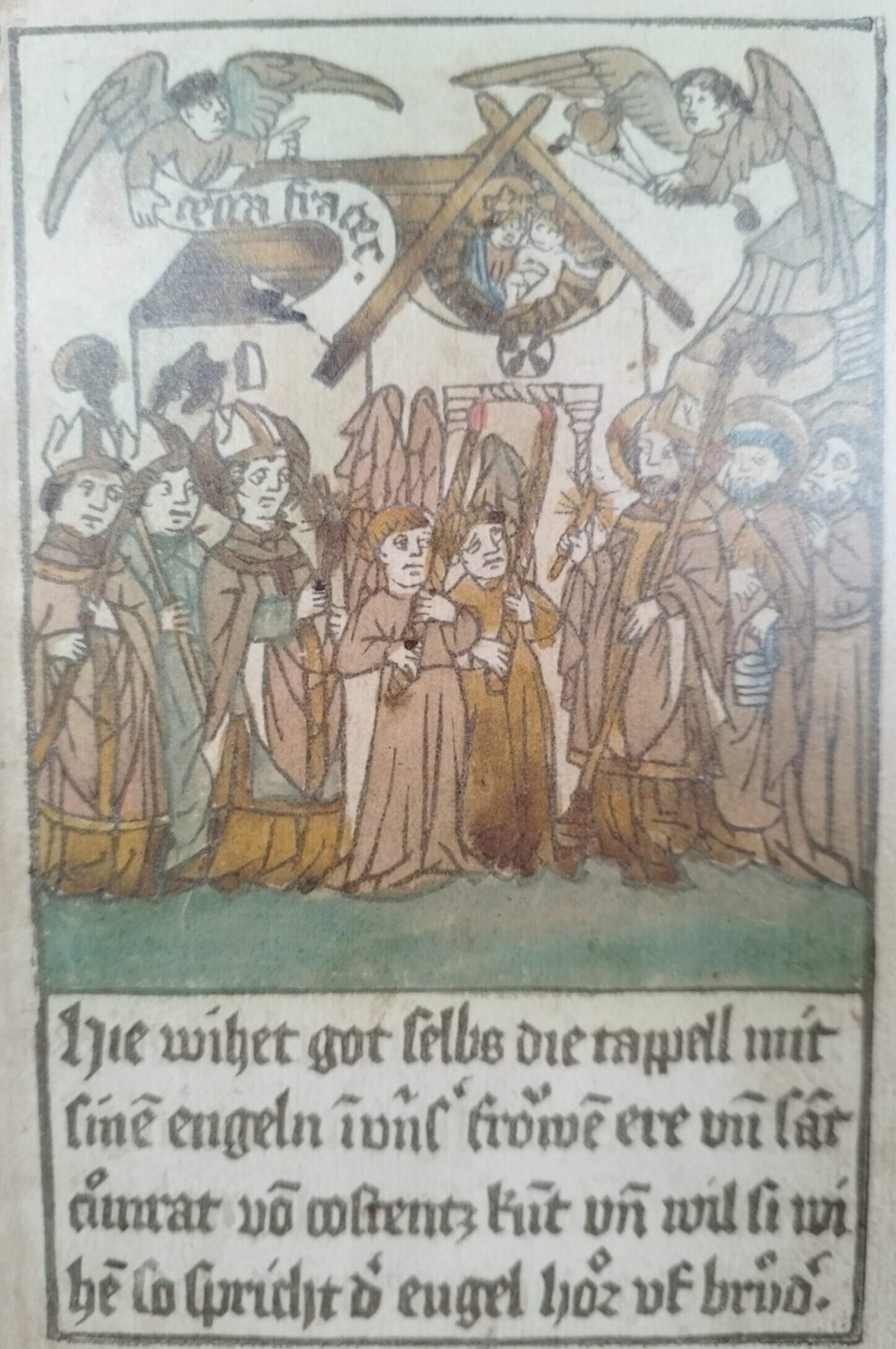
Christ himself, accompanied by a choir of angels, consecrates the newly built chapel during the night, before the consecration can be carried out the next morning by the present Bishop Conrad of Constance (angel consecration).
Pope Leo VIII and Emperor Otto I confirm the authenticity of the consecration of the angels with a document that they give to Bishop Conrad of Constance. This confirmation is of great importance because of the pilgrimage.
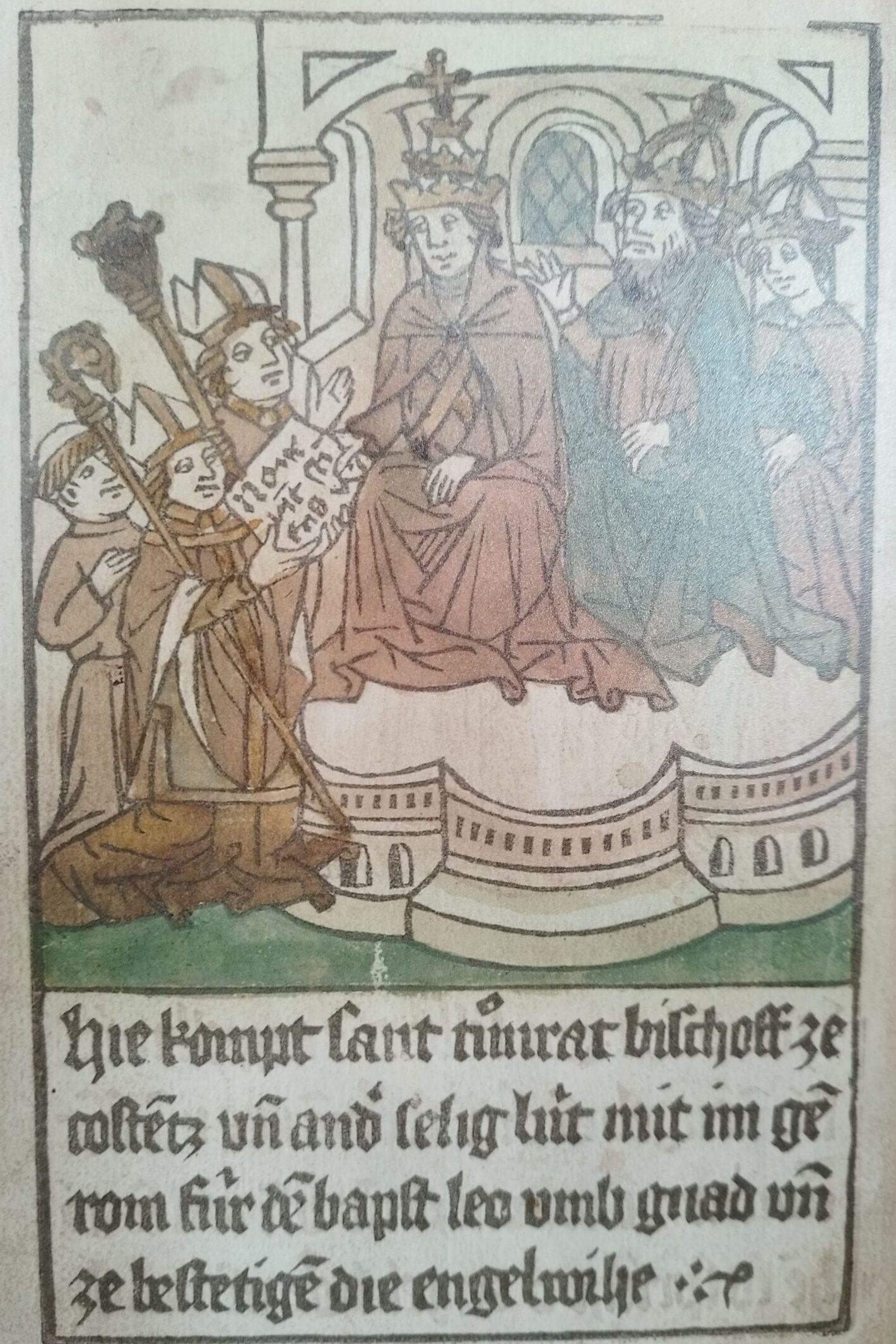
The Stations of the Cross at Einsiedeln Monastery
The individual Stations of the Cross - sometimes also called the Stations of the Fallen because the worshipers kneel down at each station - are depicted as a group of sculptures. Stations of the Cross can be designed as open-air Stations of the Cross, usually on a slope, and ideally correspond to the conditions in Jerusalem in terms of the location and distance of their stations.
1st Station: Condemnation
Jesus is condemned innocently. Pilate asks him: "What have you done?" Jesus answers: "I came into the world to bear witness to the truth. Everyone who is of the truth hears my voice." "Away with him to the cross!" shouts the crowd. Why? Because people cannot bear this truth, because they want to avoid it? Because it calls us to make changes in our lives? Because it reveals sore spots? Why are people often judged and condemned so quickly?
2nd Station: Carrying and Enduring
Jesus is given the crossbeam on which he is to be crucified. Without resisting, he carries it like the other two accused. Doesn't that remind us of his earlier enigmatic message: "Whoever wants to be my disciple must take up his cross and follow me." These words sound harsh, they don't invite you to take an easy path. However, the message is clear: Jesus carries his burden to the last step. He accepts his path, which he sees as his task, no matter how difficult it is. The Holy Scripture tells us that he also carries us so that we can carry and endure our burdens.
3rd Station: Falling
A tortured man with such a heavy burden! Does he have superhuman strength? Jesus falls down, the beam is crushing. "Jesus was equal to God, but did not cling to being like God, but became like men." We can understand Jesus' falling down as a sign of his solidarity with us humans. We often stumble and fall in life. In this event, Jesus reveals how he feels for the weak, how he knows falling, falling through, falling away. When we fall, he is close to us.
4th Station: Pity
Mary, the mother of Jesus, is moved by compassion. She does not withdraw in this distress, but shows her son that she stands by him in everything and is with him with her love. She does not leave his side, does not avoid the visible pain, accompanies him and remains present. Does not the motherly in us and around us still suffer today when we are burdened by something difficult? Just as Mary did not leave her son alone in his most difficult hour, we are not left alone in pain either. The unconditional love that Mary embodies is present. It can be a source of strength and an example for us.
5th Station: Carrying Along
Jesus' path crosses that of the surprised farmer Simon. He is perhaps on his way home. Now he is supposed to carry the beam after a "criminal". Simon does not know who this man condemned to death is. He is undoubtedly carrying the heavy wood for him. The story tells us that Simon was changed by this carrying. How are we changed when we do not leave others alone with their burden? When we stand by the oppressed without asking too many questions? When we help carry the burden?
6th Station: Alleviating Need
The crowd follows the spectacular spectacle with mockery, violence, cruelty and curiosity. Veronica, a woman on the way, has the courage to break away from the crowd. She cleanses and refreshes Jesus' battered face. People of action and courage, people who not only perceive the need but also alleviate it, are needed at all times. They can be very simple actions, like that of Veronica. Did not Jesus himself tell us: "Whatever you did for one of the least of these brothers of mine, you did for me."?
7th Station: Collapse
The brutality, the injustice, the ever more crushing burden, the physical pain cause Jesus to collapse. How close is Jesus to us in his fragility, vulnerability, humanity...! People stand around, affected, uninvolved, curious, helpless, like spectators at an accident. How do we behave in such situations? Our helplessness often makes us passive. Collapses - of any kind, others' and our own - present us with the fundamental decision of whether we turn to the weak or turn away from them.
8th Station: Compassion
Some women who witnessed Jesus' collapse were deeply moved by the suffering of another, even if that other was a criminal. They did not question him, nor did they question guilt and innocence, they simply saw the fragile human being. The prevailing opinion of the majority and judgments did not make them self-righteous and hard. Their impartiality and compassion can also be an example today. May we keep the courage and gentleness to empathize unconditionally within us.
9th Station: Ground Zero
Jesus lies on the ground. Defenceless, weakened, exhausted. He lies there like an abandoned, tormented person, used up, useless. He lies there like all people who lie on the ground. He knows what it means to lie in the dust. It is difficult to bear this image: the one who overcomes boundaries, teaches, heals in such defencelessness. He has accepted this path, in loyalty to his life's mission. He does not reject it.
10th Station: Exposure
When he arrives at the place of execution, Jesus' clothes are torn from his body. He is exposed, exposed to the gaze of many, exposed without protection. Jesus lets this happen to him too. He is on the same level as the violated, the humiliated, the exposed of every kind. How often do people degrade one another through recklessness, shamelessness, through a lack of respect - often without even noticing it. Let us be careful to behave differently on our part. Let us not allow others to be exposed without protection and despised.
11th Station: Pin it Down
Jesus, who always taught openly and freely, is nailed down. Like a piece of wood that is taken possession of and controlled. He is crucified. To nail down life - a cruel crime, an unimaginable act. Many agree on that. And yet: when we attach others to something, "hang them up", ruthlessly pin them down, are we not doing something similar? What do the invisible nails that inflict wounds look like?
12th Station: Unifying Love in the Darkest Night
A final act of earthly love and tenderness: Jesus asks the disciple John to take care of his mother and asks his mother to take John as her son. Neither of them leaves his side until his last breath. A moving and sad image that nevertheless testifies despite all the inevitable. True love does not leave us alone, even in the most extreme suffering. Now Jesus gives up his life with the words: "It is finished." "Father, into your hands I commend my spirit."
